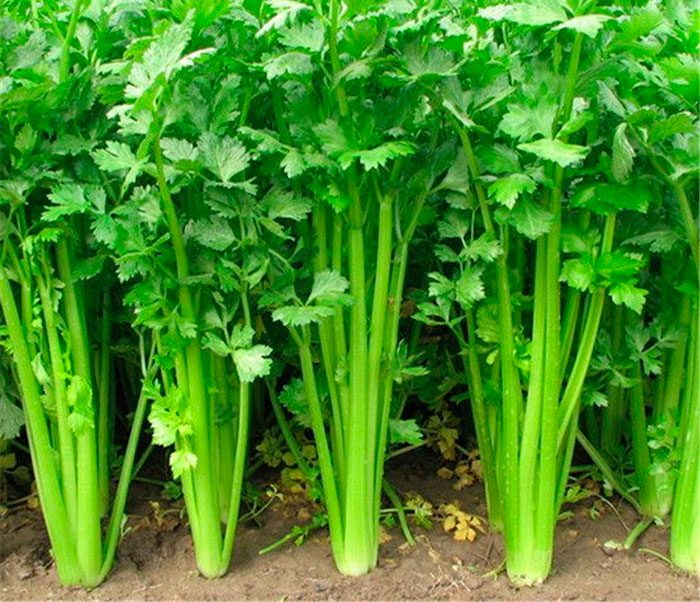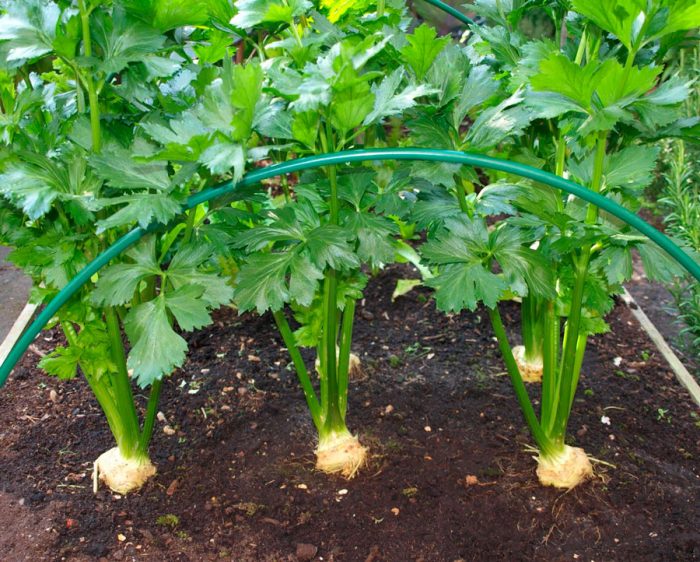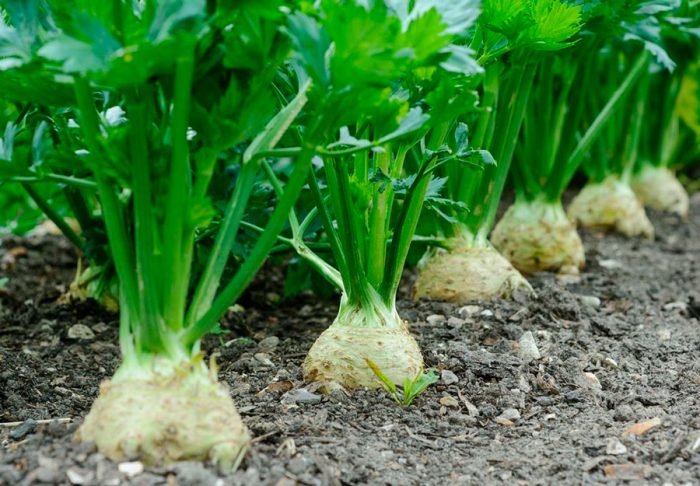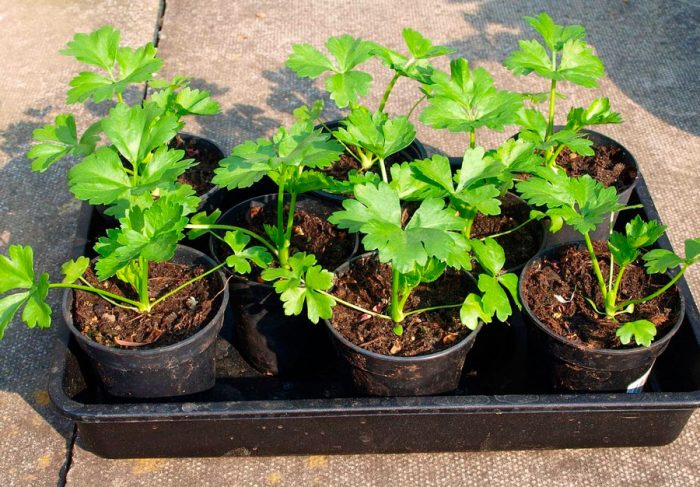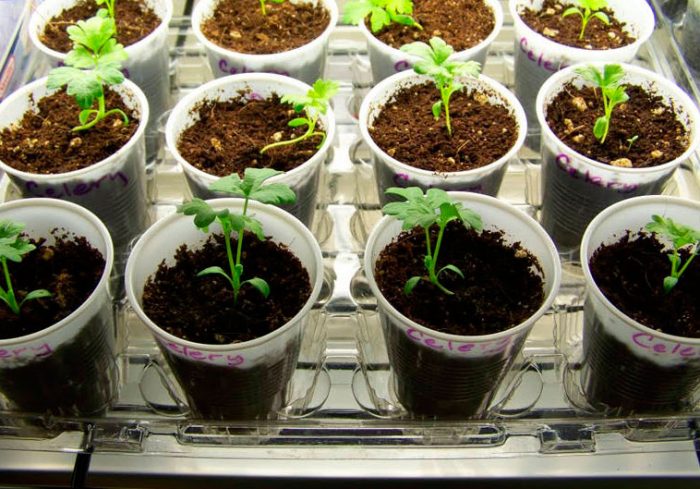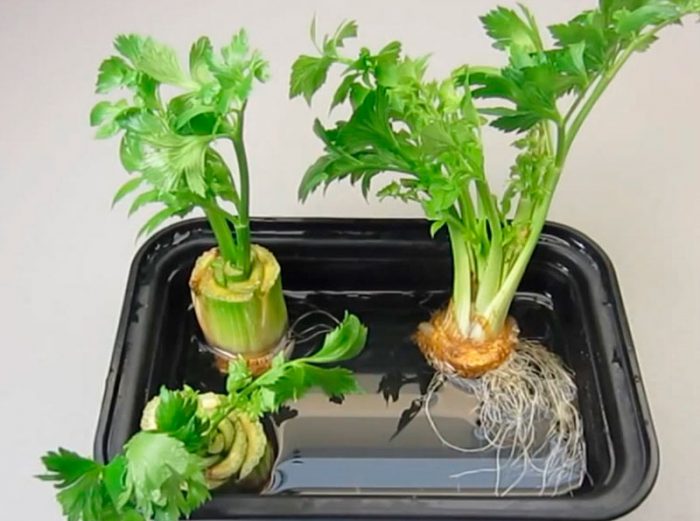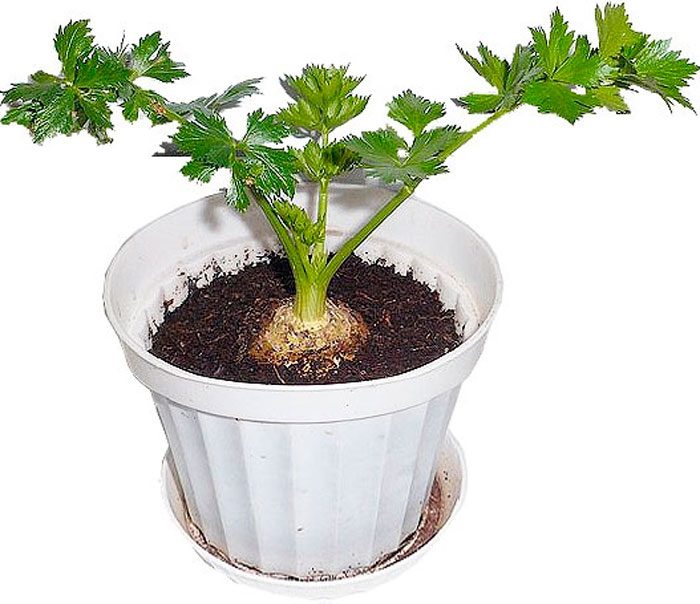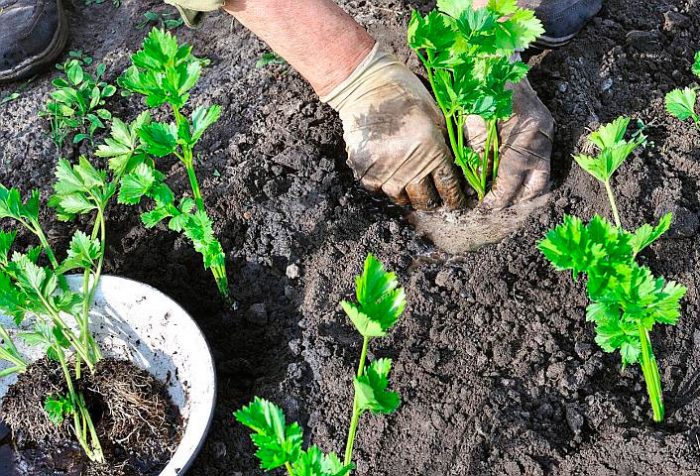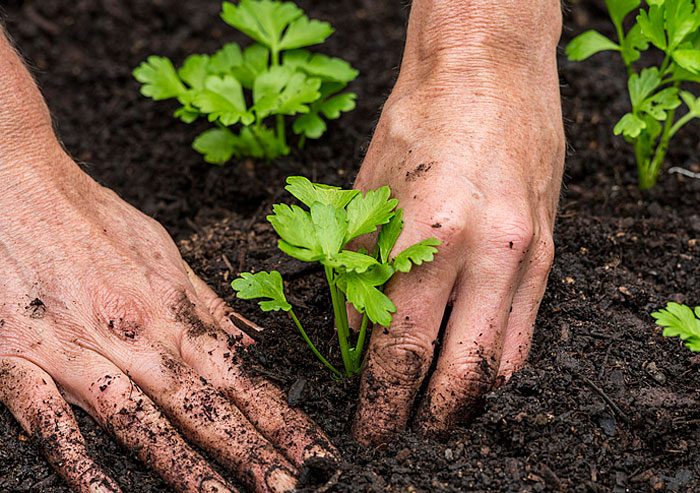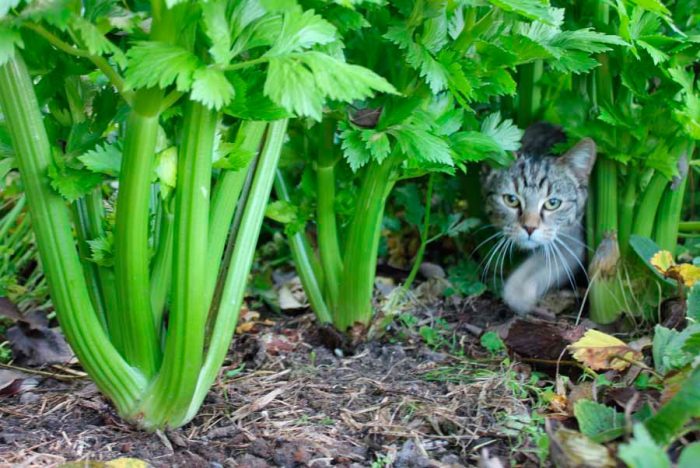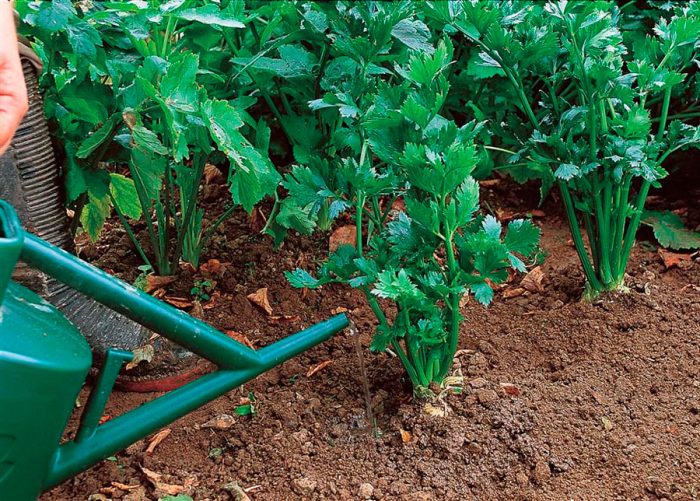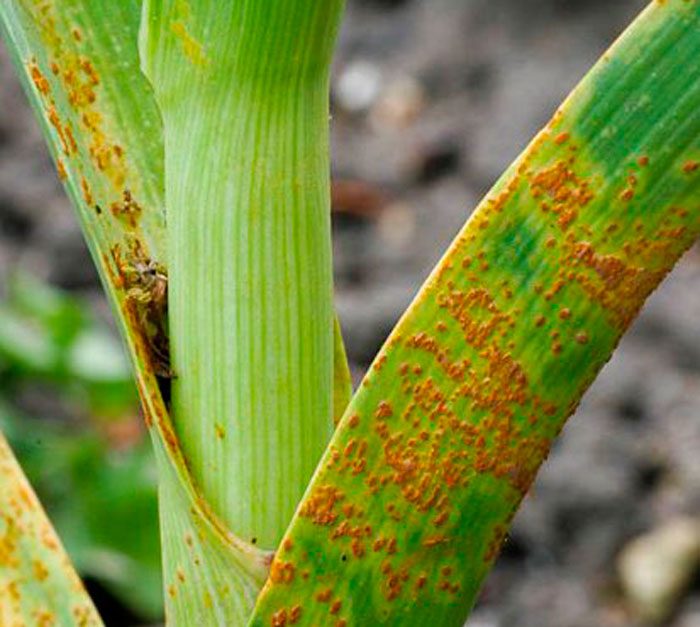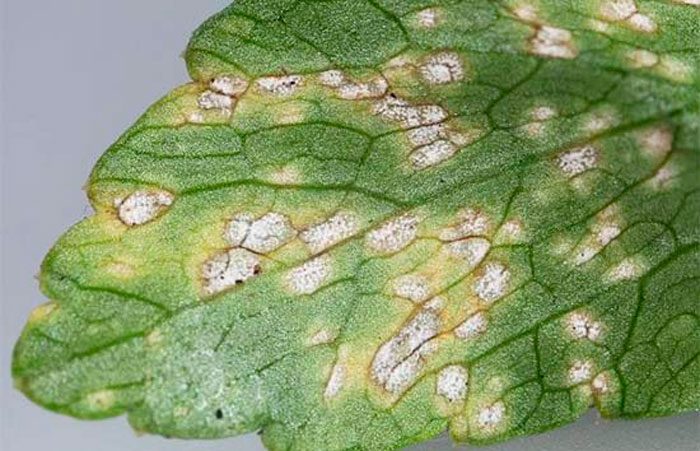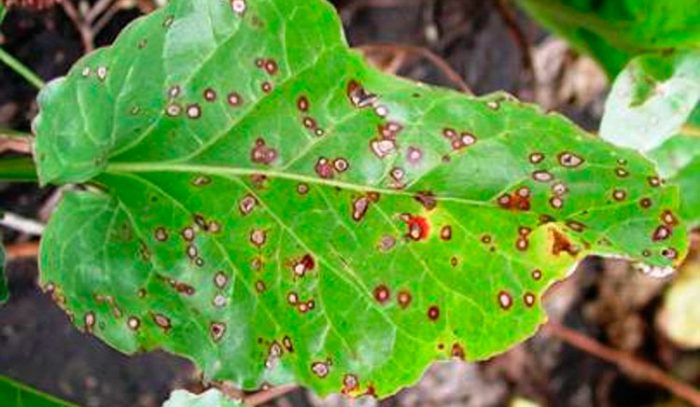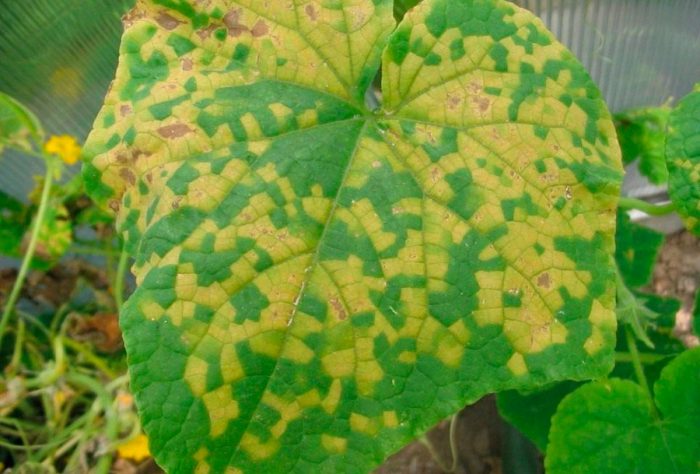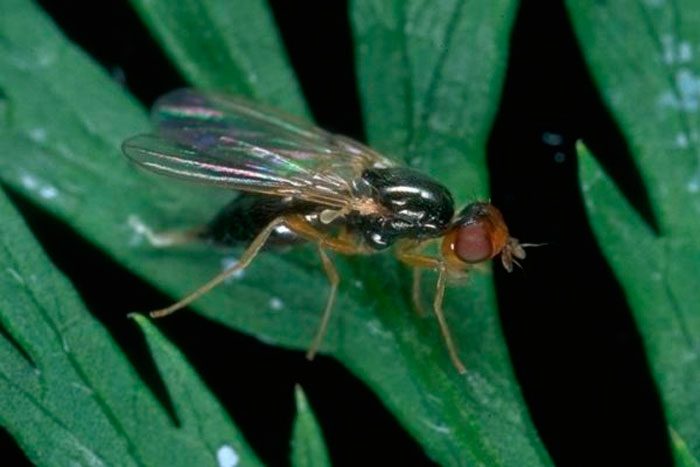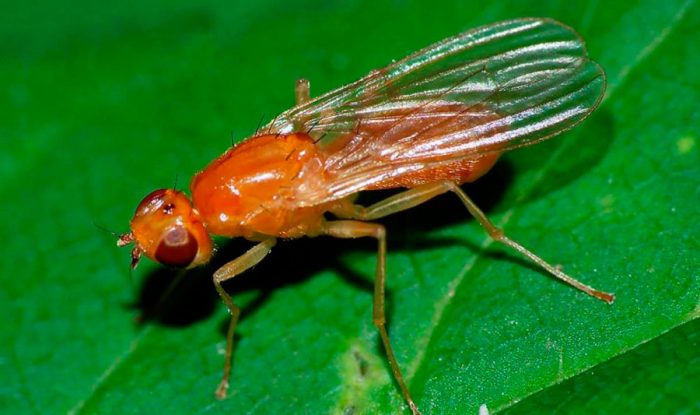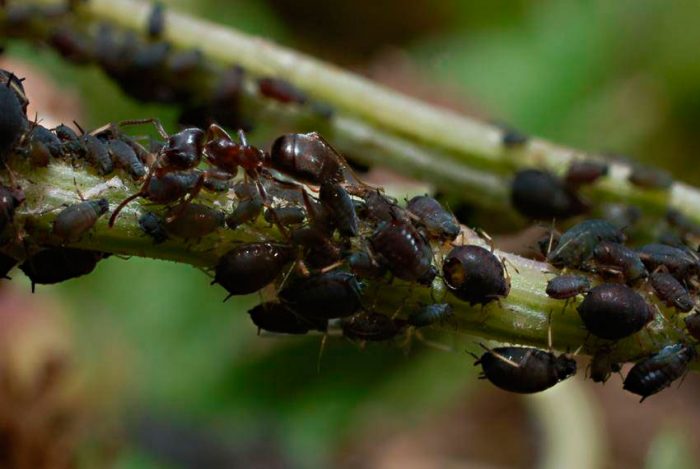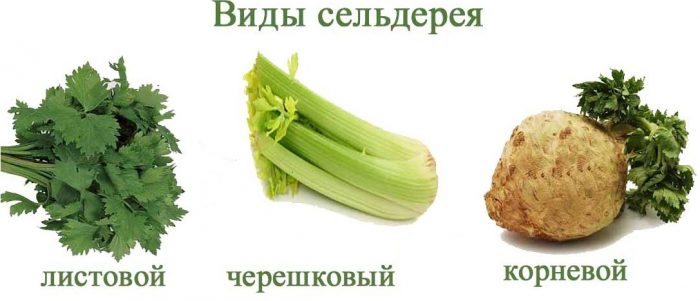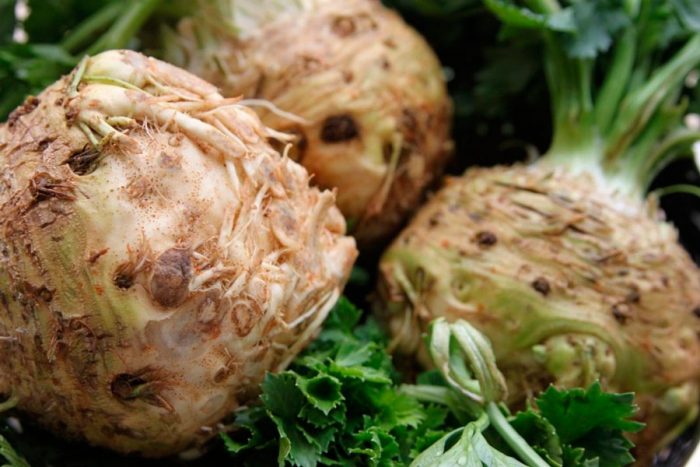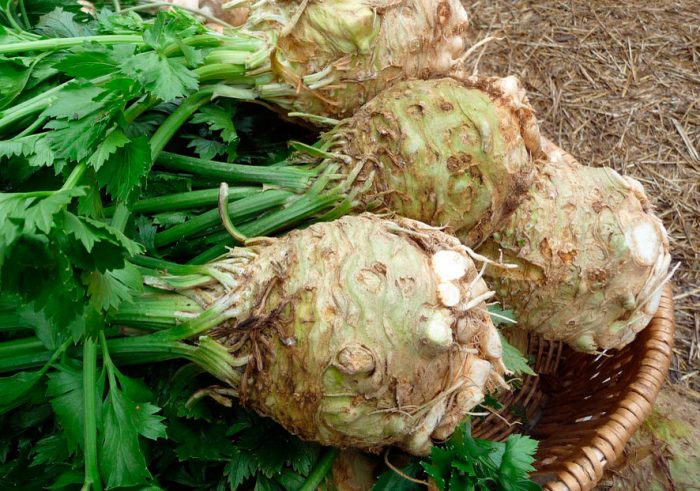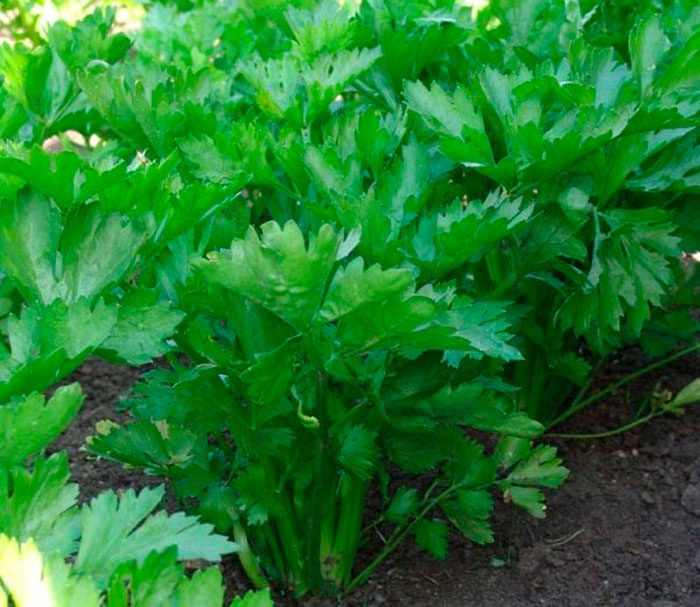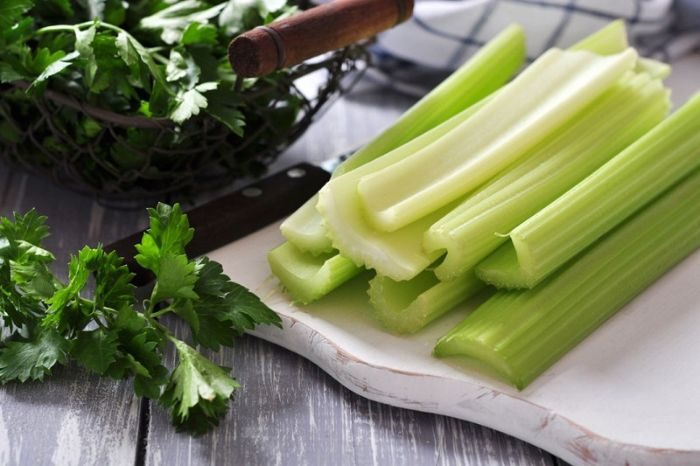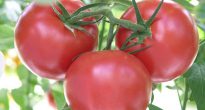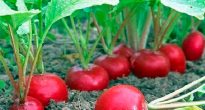The herb celery (Apium) is a member of the Umbrella family. The most popular vegetable crop among gardeners is the aromatic celery (Apium graveolens). This culture hails from the Mediterranean, and today it is found there in the wild. Celery in nature can be found on the Indian subcontinent and in other Asian countries, as well as in America and Africa, while this plant prefers to grow in humid places.
People began to cultivate such a plant a long time ago, for example, in ancient Greece, celery was grown in a special way, and only leaf petioles were used for food. And in other countries of the Ancient World, this culture was a sacred plant, so, in the Roman Empire and Egypt, celery was used to make decorations for graves, while food, which included such a plant, was used to remember the dead. In the European territory, such a culture became popular in the 18th century, while at first it was grown only for decorative purposes, and only after a while it began to be used for food. Today this plant is becoming more and more popular every year.
Content
Brief description of cultivation
- Sowing... Root celery is sown for seedlings in the last days of February, and leaf celery is sown half a month later. Seedlings are planted in open ground in the first days of May.
- Illumination... Well-lit area.
- Priming. Suitable soil should be light, loose and nutritious; sandy loam or loamy soil, which should be neutral or slightly alkaline, is best.
- Watering... Watered 1 time in 7 days, while 2–2.5 buckets of water are consumed per 1 square meter.
- Fertilizer... During the season, you will need to carry out 4 top dressing: with Nitrofoski solution, seedlings are fed 7 days after the pick; herbal infusion 7 days after transplanting seedlings into open soil; after half a month, fertilize with a solution of mullein or chicken droppings; superphosphate solution in the last days of July.
- Reproduction... Generative (seed) way.
- Harmful insects... Celery (borsch) flies, carrot flies, bean aphids.
- Diseases... Rust, septoria (late burn, or white spot), cercosporosis (early burn), peronosporosis and cucumber mosaic virus.
Features of celery
The herb celery is a biennial plant, it reaches a height of about 100 centimeters, its root is thickened. During the first year of growth, a root crop is formed in the bushes, as well as a rosette consisting of shiny pinnately dissected leaf plates of a dark green color. And in the second year of growth, shoots are formed, flowering begins in mid-July. The forming umbrellas consist of greenish-white flowers.
Such a culture is moisture-loving and frost-resistant, seed germination is observed already at 3 degrees, while friendly shoots appear at a temperature of 15 degrees. Young seedlings can withstand frosts up to minus 5 degrees. The round, almost double-shaped fruit has threadlike ribs on each half. Today, 3 varieties of celery are cultivated: leaf, root and stem (petiolate). The most popular green crops are celery, dill and parsley.
Growing celery from seeds
What time to plant
Since the duration of the growing season of celery is 120-170 days, this crop should be grown through seedlings. Sowing seeds of root celery for seedlings is carried out 70–75 days before transplanting seedlings into open soil, for example, in the last days of February. In this case, sowing of leaf celery for seedlings is carried out half a month later.
Seeds require compulsory pre-sowing preparation, since they contain essential oils that strongly inhibit the swelling and emergence of sprouts, in some cases the first seedlings appear after 20-30 days. In order for seedlings to appear as soon as possible, they must be bubbled: the seed is kept in oxygen-saturated water for 24 hours, after which it is etched, for this immersed for 45 minutes. into a solution of manganese potassium (1%), then it should be thoroughly rinsed using clean water and dried. There is another method of preparing seeds for sowing: first, they are pickled, for this they are immersed for 45 minutes. in a solution of potassium manganese (1%), then they are washed, and then immersed in Epin's solution for 18 hours (2 drops per 100 ml of water).
The treated seed should be scattered in a thin layer on a damp cloth, where they will germinate at a temperature of 20 to 22 degrees. Naked seeds are sown in a box, which is pre-filled with a fertile substrate, which includes low-lying peat, turf soil and humus (3: 1: 1), coarse sand is also added to it. In 10 liters of substrate, add 1 tbsp. wood ash and 1 tsp. urea. After some of the seeds are nailed, they are combined with a small amount of sand and sown in a container with a moistened soil mixture, in which grooves are made, while the distance between them should be from 30 to 40 mm. Seeds should be covered with a thin layer of sand, using a sieve, then the box is covered with glass or film on top and removed to a warm place.
Growing seedlings
If done correctly, the first seedlings should appear 7 days after sowing. When necessary, crops are watered with lukewarm water, using a fine-dispersed sprayer. Before the seedlings appear, the boxes must be kept warm (from 22 to 25 degrees). After seed germination, the shelter must be removed, and the containers are transferred to a well-lit place where it should be cool (about 16 degrees).
During the first 4–6 weeks, young seedlings grow rather slowly.When growing leaf and petiole celery, when the seedlings grow 1–2 true leaf plates, they are thinned out, while the distance between them should be from 40 to 50 mm, or they can be cut into a large container. At root celery, seedlings dive into individual peat-humus pots, while shortening the central root by 1/3 part. During the pick, the plant is planted in the soil in pots only up to half of the hypocotyl knee. When the seedlings are cut, they will first need protection from direct rays of the sun, for this they use moistened paper sheets. During this period, the seedlings will need the following temperature regime: in the daytime - from 15 to 16 degrees, and at night - 11-12 degrees.
Regardless of what kind of celery is grown, seedlings will need to provide good care, which consists in timely watering and feeding, as well as loosening the surface of the substrate. The first time the seedlings are fed 7-10 days after they are thinned out or cut, for this they use a solution of Nitrofoski (for 10 liters of water 1 tsp.), 2-3 tbsp is taken for 1 bush. l. nutrient mixture. If the plants are excessively pale, then they will need to be fed 2 or 3 times with a urea solution with a break of 10-12 days. In order to prevent burns on the seedlings, when they are fed, it will be necessary to wash off the remnants of the nutrient mixture from them, for this use clean water and a sieve.
When 7-10 days remain before planting seedlings in open soil, you should start hardening it. To do this, it is transferred to the street every day, while the duration of the procedure must be increased gradually, until the seedlings can be constantly in the fresh air.


Watch this video on YouTube
Growing celery on a windowsill
Sow celery seeds and grow seedlings indoors in exactly the same way as described above. Such a plant on a windowsill can also be grown from a root crop, as a result, you can get the result much faster and easier. But it should be borne in mind that a plant that was grown from seed can last a little longer. If desired, a new root crop can be planted 1 time every 2-3 months, or you can wait a little and grow this plant from a seed, such a bush can provide you with fragrant greens for more than 1 year.
To grow such a plant from a root crop, you need to take a pot, the height of which should be about 20 centimeters. Depending on the size of the root crop, 1-3 pieces can be planted in it, while after planting their upper part should rise above the surface of the substrate. The pot is filled with a substrate, which includes coconut fiber and vermicompost (2: 1), it should be tamped and watered. For growing celery, you can take a different soil mixture.
Where to get the root crop for planting? It can be purchased on the market or dug up on your site. The collection of the first fragrant greens can be done in half a month. If the bush is grown from seed, then the first cut of greens can be done only after about 6 weeks, but its growth will be observed throughout the year, and maybe even longer. It is recommended to sow seeds of early maturing varieties of root celery. When the seeds are processed before sowing, as described above, they should be sown in a moistened substrate, buried in it by half a centimeter, then the container is covered with a film or glass.
How to water
Such a culture is moisture-loving, in connection with this summer, the bushes need to be watered often and abundantly. In winter, they are watered less frequently and using less water for this. Before watering, tap water should stand for 24 hours, while it should be at room temperature.The pot with the plant must be placed on a pallet, while after watering it must be sure to drain excess liquid from it.
Fertilizer
To collect greens as long as possible, the bushes must be fed in a timely manner. Once every 15–20 days, 1 tsp should be added to the upper layer of the substrate. Agrolife or once every 7 days, the bushes are watered with a solution of the Growth preparation (1 cap for 2 liters of water).
If the celery is well cared for, then a bush grown from a root vegetable will produce greens for 3-4 months, and from a seed - longer than a year.


Watch this video on YouTube
Planting celery outdoors
What time to plant
It is necessary to start planting celery seedlings in open soil after 4–5 true leaf plates are formed in the plants, while they should reach a height of 12 to 15 centimeters. At the same time, at least 50-60 days should pass from the moment the seedlings appear. When it remains from 2 to 3 hours before planting the bushes in open ground, they will need abundant watering. Transplanting seedlings into open soil should be carried out in the middle of the first decade of May. Root celery seedlings should not be overexposed, otherwise the chances of getting a high-quality and rich harvest are significantly reduced. Well-watered seedlings are very easily removed from the container during transplantation, while they are taken along with an earthen clod.
Suitable soil
Before planting seedlings in open soil, be sure to thoroughly prepare the site. Such a culture needs a light loose nutritious sandy loam soil, which should be slightly alkaline or neutral. The site must be open and well lit. For such a plant, areas where crops such as cabbage, cucumbers, legumes and tomatoes were previously grown are excellent. Bad predecessors are parsley, carrots, dill and parsnips.
Site preparation should be done in the autumn. To do this, dig the soil to the depth of a shovel bayonet, while adding 20 grams of double superphosphate and 3.5–4 kilograms of compost or humus per 1 square meter of land. In spring, the soil on the garden bed must be loosened, and 35–40 grams of complex mineral fertilizer should be added to it per 1 square meter of the plot.
Landing rules
When planting root celery seedlings, a distance of 0.4 to 0.5 m should be observed between the bushes, while the distance between the rows should be the same. And when planting leaf and stem celery, the distance between the bushes should be from 15 to 20 centimeters, and the row spacing should be about 30 centimeters. If desired, celery bushes can be planted between the beds of potatoes, garlic or onions.
In each of the planting holes, it is necessary to pour 1 handful of wood ash and humus, while the fertilizers are combined with the soil. During planting, the plant is buried in the ground up to the cotyledonous knee. Then the soil near the seedlings is well tamped, and the planted plants themselves are watered abundantly. Transplanted seedlings must be protected from direct sunlight with paper sheets for the first few days.


Watch this video on YouTube
Celery care
Growing and caring for stalked celery should be different from leaf or root. Any of the varieties of such a plant should be provided with timely watering, weeding, feeding, mulching and loosening of the soil surface, and it is also necessary to treat the bushes from diseases and harmful insects if necessary.
In order for moisture to remain in the soil longer, and no crust appears on its surface, the bed with celery must be covered with a mulching layer (sawdust, peat or cut grass).When 20 days are left before harvesting the stalk (petiolate) celery, the bushes will need to be piled high, this will whiten the stalks, as well as reduce the bitter taste in them and reduce the amount of essential oils that have a pungent aroma. If root celery grows in the garden, then in the middle of the summer period it is necessary to remove the soil from its upper part, while also removing the side roots and pressing the foliage to the surface of the site. If the leaves break at the same time, then this will not harm the bush at all, but will contribute to the formation of a larger root crop. Petiole and root celery are harvested completely at harvest time. And when harvesting the leafy variety, the bushes can be used for forcing indoors in winter. For this, the bush is taken together with an earthen lump before the first frosts come, after which it is planted in a pot.
How to water
This culture is hygrophilous, so it is watered once every 7 days, spending 2–2.5 buckets of water per 1 square meter of the bed. The earth must not be allowed to dry out. During dry periods, watering should be carried out once a day. The soil in the bed should be constantly slightly damp. It is necessary to water the bushes at the root.
Fertilizer
To harvest a rich crop of this crop, 4 additional dressings will be required throughout the season. How to feed seedlings is described above. 7 days after transplanting the seedlings into open soil, it must be fed with an infusion of grass, and after another half a month the plants are fertilized with infusion of chicken manure or mullein. Then, at the end of July, superphosphate should be added to the soil (30 grams per 1 square meter of plot).
What to plant after celery
In the area where celery was grown last year, you can plant garlic, tomatoes, onions, legumes and potatoes.
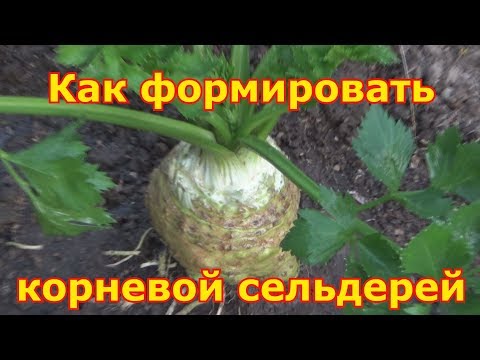

Watch this video on YouTube
Diseases and pests of celery photos and names
Diseases
When grown in open soil, celery can be affected by the following diseases:
Rust
Signs of this disease can be detected at the beginning of the summer period. Brown-red pads appear on the surface of the underside of foliage, petioles and shoots. Over time, the affected parts of the bush turn yellow and dry out, while they lose their taste. To get rid of the disease, the bushes must be sprayed with a solution of Fitosporin-M (for 1 liter of water 4-5 milligrams), while 100 ml of the mixture will be enough to process 1 square meter of the plot.
White spot (septoria or late burn)
Bushes usually get sick in the last weeks of summer. In affected plants, many yellow spots are formed on the foliage, and on the petioles - depressed brownish-brown spots of an oblong shape. The disease develops most actively in damp cold weather. Sick bushes will need treatment with Topsin-M or Fundazol solution. When 20 days remain before harvesting, all processing should be stopped.
Early burn, or cercospora
The development of such a disease is facilitated by cold rainy weather with sharp temperature fluctuations. In the affected plants, on the surface of the foliage, many specks of a round shape are formed, which reach half a centimeter in diameter, have a pale center and a brown border. On the surface of the petioles, oblong spots appear, and with increased air humidity, a bloom of purple color forms on them. Over time, the affected foliage and petioles dry out. This disease is fought in the same way as with septoria.
Downy mildew
It affects the aerial part of the bush, while a cobweb bloom of a whitish color appears on it, as the disease progresses, it becomes a felt film, on the surface of which there are black dots. The disease is actively developing with sudden changes in temperature and humidity, as well as with cold dew.Best of all, an infusion of sow thistle copes with this disease. To prepare it, you need to combine half a bucket of water with 0.3 kg of crushed sow thistle, the mixture should be infused for 8 hours.
Cucumber mosaic
This disease is viral. The signs of this disease directly depend on the type of strain that has hit the bush: large rings may appear on the top of the celery, which contribute to its deformation, and very small rings may form that slow down the growth of the plant. All diseased bushes must be dug up as soon as possible and destroyed. Since this disease is not amenable to treatment, in order to prevent it, it is necessary to protect the culture from its main carriers: ticks and aphids.
In order not to use harmful chemicals for spraying diseased plants, you should adhere to the rules of prevention:
- be sure to carry out pre-sowing preparation of seed;
- adhere to the rules of crop rotation and agricultural technology of this crop;
- prevent thickening of the landings;
- in the autumn, when the entire crop is harvested, all plant residues must be removed from the site, as well as a deep digging of the soil must be carried out.
Pests
Most often, such pests settle on celery bushes:
Borsch (celery) fly
In the last days of May, this pest flies on celery from the hogweed to lay eggs under the skin of the leaf plates, as a result of which tubercles appear on their surface. The larvae that appear gnaw out the foliage tissue, while long passages remain after them. Because of this, the petioles become bitter in taste, while you cannot count on a good harvest of celery. In order for such pests not to appear on your site, it is imperative to pull out weeds in a timely manner, and you also need to plant an onion near the celery garden, which is able to scare off such a fly.
Carrot fly
It appears in springtime and arranges egg-laying under the celery bushes, and the larvae of such a pest injure their shoots, roots and leaf plates. During the season, this fly gives 2 generations. In order to destroy such a pest, it is necessary to carry out several treatments with a break of 7 days, for this the aisles are covered with a layer of a mixture consisting of sand, dry mustard and tobacco dust (1: 1: 1).
Bean aphid
This aphid species is the largest of all. It takes only half a month to develop one generation of such a pest. Aphids are a sucking insect that can bite through the surface of a leaf plate and suck sap out of it. It should also be remembered that such a pest is the main carrier of dangerous diseases for which effective drugs have not yet been found. In this regard, as soon as the aphid is noticed on the site, you need to immediately start fighting it. For example, the bushes can be treated with an infusion or a decoction based on the tops of potatoes, tomatoes or dandelions. An infusion of citrus peels is also suitable for this purpose, for its preparation you need to combine water (10 parts) with the peels (1 part), mix everything well and leave to infuse for 3-5 days. For prevention purposes, it is necessary to weed the site on time, and after the harvest is harvested, the site is cleaned of plant residues, and then a deep digging of the soil is carried out.
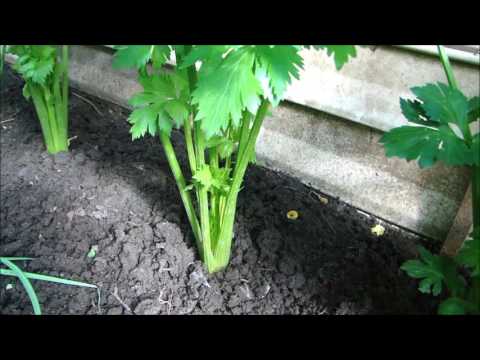

Watch this video on YouTube
Types and varieties of celery
It was already mentioned above that leaf, root and stem (petiolate) celery is most popular among gardeners.
Root celery
Such celery is usually cultivated for the purpose of obtaining a root that has medicinal properties similar to those of the ginseng root. The mass of root crops varies from 0.5 to 0.9 kilograms.The minimum duration of the growing season for this plant is 120 days, therefore, only mid-early, medium and late varieties are isolated from it. The most popular are the following medium early varieties:
- Prague giant... From the moment the seedlings appear and until the root crops fully ripen, it takes about 120 days. Large roots have a turnip shape. Their fragrant delicate pulp has a light color and high taste.
- Apple... This variety is distinguished by its yield and disease resistance. The ripening time of root crops depends entirely on weather conditions and is 90–160 days. The mass of rounded root crops is 80–140 grams. The flesh, saturated with sugars, has a snow-white color. Root crops have good keeping quality.
- Gribovsky... The duration of the growing season for such a celery is from 120 to 150 days. The shape of the root crops is round, their weight varies from 65 to 135 grams. The light, fragrant pulp has yellow specks. Such root vegetables are eaten fresh, and even dried.
- globe... Large roots are rounded, their weight varies from 150 to 300 grams. The dense and juicy white pulp has rather small voids.
- Diamond... The variety is resistant to shooting, the duration of its growing season is about 150 days. Smooth, rounded roots have an average weight of about 200 grams. After heat treatment, the pulp retains its white color.
Popular varieties of medium ripening:
- Albin... This variety has a high yield, its roots ripen in 120 days. Root crops are rounded in diameter up to 12 centimeters. The juicy pulp has no voids and is colored white.
- Egor... Fruit ripening lasts 170 days. Rounded large and smooth roots weigh about 0.5 kilograms, they are painted in a gray-yellow color with green. The white flesh is sweet and aromatic.
- Esaul... Whitish-gray large rounded roots weigh about 300 grams, their ripening lasts 150-160 days. In root crops, the roots are in their lower part.
- Strongman... In this variety, the roots have a rounded shape, and they ripen in about 170 days. They are yellowish-white and weigh about 0.4 kg. The white pulp is fragrant and sweet.
- Giant... In this high-yielding variety, the roots are pale beige and weigh about 0.7 kilograms.
The following late-ripening varieties are popular among gardeners:
- Anita... The variety is distinguished by its yield and resistance to shooting. Root crops fully ripen in 160 days, they are painted in a pale beige color and have an oval or round shape, and their weight is about 0.4 kilograms. After heat treatment, the snow-white pulp does not lose its color.
- Maxim... Ripening of rounded root crops lasts about 200 days, their mass can reach 0.5 kilograms. The pulp has a creamy color and a spicy delicate taste.
Leafy celery
Leaf celery is cultivated to obtain fragrant foliage containing many vitamins, which is harvested throughout the summer. In this variety, the formation of root crops does not occur. The most popular varieties are:
- Cartouli... Medium early variety of Georgian selection is drought and cold resistant. On the petioles of a dark green color, fragrant leaf plates are located, which grow several times over the summer. The foliage is eaten fresh and dried.
- Tender... In this medium-early variety, the onset of technical ripeness occurs 105–110 days after the seedlings appear. The foliage can be eaten fresh or dried.
- Sail... This early variety, distinguished by its yield, ripens in just 85–90 days. The foliage is delicious and very fragrant.
- Zakhar... The medium ripening variety has a very high yield.During the growing season, it produces 2-3 times more greenery in comparison with other types of leaf celery. The delicate foliage is quite fragrant.
- Cheerfulness... A versatile medium-ripening variety that is distinguished by drought and cold resistance. It ripens in 65–70 days. Shiny strongly dissected leaf plates are quite fragrant.
- Samurai... This medium-ripening variety is the most popular of all leaf celery varieties among gardeners. The leaves of the bush are strongly corrugated and fragrant, they are similar to curly parsley. This variety reaches maturity in 80–85 days.
- Spartan... The variety ripens in 80–85 days; large fragrant leaf plates are colored dark green.
Celery stalk (petiolate)
Petiole celery is valued for its fleshy petioles, their thickness reaches 40-50 mm. This variety does not form root crops. Popular varieties of stalked celery:
- Malachite... In such a mid-early variety, juicy thick and fleshy petioles grow in 80 days. The foliage is dark green.
- Gold... This mid-early variety matures for 150 days. The peculiarity of very tasty petioles is that they can be bleached on their own.
- Tango... Ripening of this medium late variety lasts 170–180 days. Strongly curved blue-green long petioles are special in that they lack coarse fibers.
- Triumph... Such a medium-late variety grows fleshy and juicy petioles of a dark green color, in length they can reach 25-30 centimeters.
In addition to the varieties of celery that were described above, gardeners also grow such as: Yudinka, Snezhniy ball, Pascal, Odzhansky, Non Plus Ultra, Cascade, Zvindra, Delikates, etc.


Watch this video on YouTube
Celery properties: harm and benefit
Useful properties of celery
Root crops and celery foliage contain substances that are very valuable for the human body, for example: amino acids, carotene, nicotinic acid, essential oils, boron, chlorine, calcium, iron, manganese, magnesium, zinc, potassium, selenium, phosphorus, sulfur, vitamins A, C, E, K, B1, B2, B3, B5, B6 and fiber.
The set of vitamins, minerals, proteins and acids in this plant is unique, thanks to which celery helps to ensure the stability of cells in the body, as well as slow down the aging process. The greens of this culture are used during the therapy of nervous disorders that have appeared due to overwork, since it has a sedative effect. The essential oil contained in the plant helps to stimulate the secretion of gastric juice. Celery foliage contributes to the normalization of metabolic processes in the body, so it is recommended to include it in the diet of diabetics. It is also recommended to be consumed by people of age who need to stimulate water-salt metabolism in the body. The bush contains coumarins, which help to eliminate painful sensations in the head with migraines. It has an anti-inflammatory effect, while the culture helps to reduce swelling and eliminate joint pain in arthritis, gout and rheumatism. This plant also has a wound-healing, antimicrobial, antiallergic, anti-inflammatory and laxative effect. It tones the body and improves physical and mental performance. Celery juice helps to cleanse the blood and get rid of skin diseases, especially when combined with the juice of nettle and dandelion. It is used for diseases of the digestive tract, urticaria, diathesis and urolithiasis. Celery is also used externally in the presence of wounds, inflammations, ulcers and burns; for this, the herbs are crushed with a meat grinder and mixed with melted cow butter (1: 1).
Means made on the basis of celery help to enhance male sexual function, eliminate insomnia, normalize metabolic processes and liver and kidney function, get rid of various pains, reduce weight, and are also used to prevent atherosclerosis. During the treatment of diseases of the heart and blood vessels, celery root is used, thanks to it, the amount of cholesterol in the blood decreases, the pressure decreases and the activity of the heart muscle is normalized. The composition of such a plant contains a lot of fiber, which helps to improve intestinal peristalsis and relieve constipation. The use of the root of this plant in food is recommended for men suffering from chronic prostatitis, as it significantly improves the functioning of the prostate gland by improving blood supply. In addition, this culture is one of the most powerful aphrodisiacs that enhance sex drive.
The medicinal properties of this culture are as follows:
- helps to get rid of diseases of the heart and blood vessels;
- makes the immune system stronger and protects the body from infections;
- eliminates anxiety and has a beneficial effect on the nervous system;
- helps to cure hypertension, kidney and genitourinary system diseases;
- promotes the stimulation of the digestive system;
- removes putrefactive processes in the intestines;
- with gastritis and stomach ulcers, eliminates inflammation and pain;
- provides easier assimilation of proteins.


Watch this video on YouTube
Contraindications
Celery helps to stimulate the digestive system, so it is not recommended to use it for stomach ulcers, high acidity of gastric juice or gastritis. Also, it can not be used for varicose veins and thrombophlebitis. Also, it should not be eaten by pregnant women. It is also not recommended to eat it during breastfeeding, as essential oils can pass into milk.

